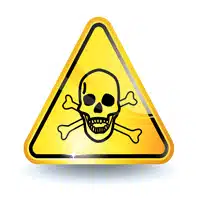Some of the most serious workplace injuries involve employees being burned. The most common types of workplace burns are relatively minor, but others can cause extreme pain, skin and tissue damage, possible amputation, and even death.
Burns can occur in restaurants, factories, construction sites, or even commercial office buildings. Employers of all types have an obligation to protect their workers from being burned at work. When an employee is burned on the job, they should be covered under Workers’ Compensation.
Most people are familiar with burns that result from contact with a hot object, such as a stovetop or a household iron, but there are many different types of burns. In workplaces across many industries, there are a variety of dangerous substances, equipment, and situations that put workers in danger of being seriously hurt. Some common types of workplace burn injuries include:
- Thermal Burns: Burns that are caused by contact with a burning fire or an extremely hot surface are considered thermal burns. Other sources of thermal burns include hot water, hot oil, or steam. Thermal burns can cause damage when a person touches a hot object, is splashed with hot liquid, or comes into contact with an open flame.
- Electrical Burns: Electrical currents cause electrical burns. Contact with sources of electricity, such as outlets or electrical machinery, can result in electrical burns that cause damage to the contact site. In addition to these direct contact burns, electricity also presents a danger of being burned through indirect contact, such as arcing. An arc burn can happen when the current passes into a person’s body and causes damage to the tissues at the contact site.
- Chemical Burns: Acids and other corrosive materials can cause chemical burns. Heavy-duty cleaners or solvents can be hazardous for workers who use these strong chemicals. Chemical burns cause harm to a person’s skin, but the fumes that often accompany these chemicals can also result in burns to the eyes or lungs.
How are Burn Injuries Classified?
Burn injuries are classified according to the severity of the damage to the skin:
- First-Degree Burns: First-degree burns are surface-level injuries that damage the epidermis, which is the skin’s top layer. These burns do not usually require medical attention.
- Second-Degree Burns: These burns go a layer deeper, causing damage to the dermis of the skin, which is just below the epidermis. These burns may call for a trip to the emergency room.
- Third-Degree Burns: Third-degree burns are the most serious. Third-degree burns cause harm to every layer of the skin and reach the tissues beneath. The damage caused by third-degree burns must be treated in a hospital. These serious burn injuries can cause severe pain and lasting damage.
Who is at Risk of Severe Workplace Burn Injuries?
Firefighters, restaurant workers, construction crews, car mechanics, and factory personnel are at high risk of suffering from a burn injury at work. Even employees whose jobs do not involve working directly with heat sources or dangerous chemicals can still be burned if a fire breaks out in the office, a damaged outlet creates an electrocution hazard, or a staff coffee machine spews hot liquid.
What Actions Should be Taken in the Workplace to Prevent Burn Injuries?
Employers should implement safety protocols to keep their employees safe from the threat of burns in the workplace. Each industry and individual workplace will need to address its specific risks, but some recommendations include:
- Safety Protocols: Employers should establish a set of safety protocols that directly address the specific dangers their workers face on the job. The safety practices that keep a restaurant worker from getting burned on a hot stove will not keep a firefighter safe from a room full of open flames. Employers should assess the burn hazards present on the jobsite and come up with plans for how workers can be protected.
- Training: The most important factor that influences the success of a burn safety plan is its implementation. Among workers, this can only be achieved if the staff is fully trained and constantly aware of possible burn dangers. Training is necessary, and not just when a worker first starts the job, training should be ongoing.
- Personal Protective Equipment (PPE): Employers should provide all necessary PPE to shield workers from dangerous burns. Gloves and other wearable protections from heat and dangerous substances offer a layer of defense against burns for workers handling hot equipment or liquids. Certain tools, such as lifts or dollies, can allow workers to avoid any manual contact, while splatter shields and other guards can prevent splash injuries.
- Safety Assessments: It is vital for employers to maintain vigilance to prevent workplace burns. Safety inspections should be performed on a regular basis to identify burn hazards, including physical dangers and an assessment of safety protocols.
Milford Work Injury Lawyers at Rhoades & Morrow Assist Employees Suffering From Occupational Burn Injuries
If you were severely burned at work, you might be able to collect benefits from your employer’s Workers’ Compensation program. If you have been denied benefits or you are experiencing other problems, the Milford work injury lawyers at Rhoades & Morrow can help protect your rights. Workplace burn injuries can be extremely severe and debilitating, and we can help you with your case. Call us at (302) 422-6705 or complete our online form for a free consultation and more information. We have offices located in Wilmington, Bear, and Milford, Delaware, and we serve clients throughout Middletown, Dover, Milford, Lewes, Rehoboth, Elsmere, and Seaford.





